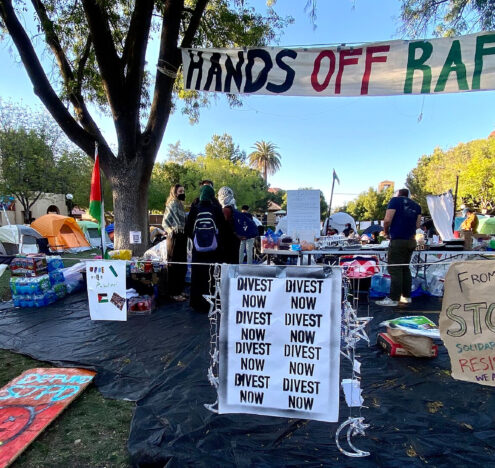“Adults in a Room” is a series in collaboration with The Stimson Center’s Reimagining US Grand Strategy program. The series stems from the group’s monthly networking events that call on analysts to gather virtually and hash out a salient topic. It aims to give you a peek into their Zoom room and a deep understanding of the issue at hand in less than the time it takes to sip your morning coffee without the jargon, acronyms, and stuffiness that often come with expertise.
In an age of comparatively limited global combat scenarios, a large portion of the power that the United States wields lies in its economic empire, which means that various forms of economic statecraft come into play on the world stage. The conversation in recent years has primarily centered on the effectiveness of sanctions — a frequently used part of the US economic toolbox, and the threat of global de-dollarization. In examining these and other economic phenomena, the primary questions remain twofold: what does the US intend to get out of a particular use of economic statecraft and, does such action achieve those goals; and what is the full list of tools the US has at its disposal, anyway?
The Reimagining US Grand Strategy program’s October 2023 roundtable brought experts together to discuss these critical matters of economic statecraft and the path forward for US economic policy. The conversation focused on deconstructing the actual threat level of de-dollarization and illuminating the lack of a cohesive and effective US geoeconomic strategy. Four experts weigh in on the matter below.
Emma Ashford, Senior Fellow, Stimson Center’s Reimagining US Grand Strategy Program
The last few years have seen a notable rise in the public discussion of geo-economic issues, and in the active use of economic statecraft as a core component of US foreign policy. Certainly, the use of sanctions — and the growth of targeted financial sanctions in particular — has been a regular feature of US policy since at least 2001. But since the Trump administration, we’ve also seen a growing profusion of tools of economic statecraft, including export controls, non-tariff trade barriers, and domestic industrial policy, along with the erosion of more traditional barriers between domestic economic and foreign policy. Whether it’s the idea of “friendshoring” to secure supply chains, or the Biden administration’s concept of a “foreign policy for the middle class,” economic statecraft has moved front and center in US foreign policy.
The toolkit for economic statecraft has expanded dramatically in the last few years, but policymakers have yet to figure out how to use it wisely and in targeted ways so that it produces more benefits than costs.
Emma Ashford
At the same time, it’s not necessarily clear that this expanded set of geo-economic tools has necessarily produced the results that proponents seek. Though de-dollarization remains a distant concern, it is still problematic that a growing number of states are seeking ways to circumvent US sanctions, potentially reducing our future leverage. Other tools of economic statecraft may be leaving us poorer, such as the Trump era national security tariffs, which largely redirected trade through intermediary states, without reducing overall supply-chain reliance on China. And still other tools aren’t producing the desired effects. Export controls on semiconductors, for example, appear to be stimulating domestic industry within China, rather than inhibiting its growth. The Biden administration has also struggled to offer a positive vision of economic statecraft, in which US market access can be used as an incentive to build ties with states in the Global South, and with allies.
In short, the toolkit for economic statecraft has expanded dramatically in the last few years. But policymakers have yet to figure out how to use it wisely and in targeted ways so that it produces more benefits than costs.
Ferial Ara Saeed, CEO of Telegraph Strategies LLC & former senior American diplomat
America’s superpower has always been its economic heft, which underwrites its military and technological superiority and soft power. But over the past decade, American politicians have come to regard decades of free market orthodoxy and economic interdependence as a risk to US economic security, leading policymakers to turn toward economic warfare to mitigate the perceived risks. These same tools have also been used to deliver a muscular response to tough foreign policy challenges in the wake of public opposition to US military entanglements post-Iraq and Afghanistan. The combined impact has disrupted the rules-based order the United States built, led, and prospered under, fragmenting the global economy. The ultimate result of this distortion of free markets will imperil American power, prosperity, and security.
The unprecedented move by the United States and Europe to disappear Russia’s official overseas reserves last year failed to turn the “ruble to rubble,” but it has cost the United States. While the Federal Reserve contends the sanctions did not prompt a major reallocation of US dollar reserves held by foreign central banks, a leading currency expert has demonstrated that, adjusted for price, the dollar’s share of reserves dropped ten times faster over the past year than the prior 20 years. This first-ever violation of a major player’s property rights heightened the perception of political risk associated with holding dollar reserves. Washington is complacent because there are no real prospects for de-dollarization, no rivals to the US dollar on the horizon. But the more the US dollar is displaced as the global currency of choice, the more America’s coercive power is degraded.
Sanctions, export controls and other constraint-based measures are vital policy tools, but the government’s over-use of these tools will make the country less economically secure over the long term, as unintended consequences pile up. The answer is to require policymakers to conduct domestic impact assessments before pulling the trigger, and a concerted effort to build economic and financial fluency government-wide to make accurate assessments.
Sanctions, export controls and other constraint-based measures are vital policy tools, but the government’s over-use of these tools will make the country less economically secure over the long term, as unintended consequences pile up.
Ferial Ara Saeed
Protecting America’s global position requires intelligent trade-offs. Though the US dollar is not in danger of being replaced, it is being displaced in trade, and trade is a platform for internationalizing a currency – one reason why the domestic backlash to free trade is damaging long-term. At the same time, trade flows are a less significant vehicle for de-dollarization than debt, which is a multiple of those flows. The dollar is king because of a liquid, transparent, easy to hedge derivatives market. If more debt is denominated in renminbi, that could be concerning, a clearer indicator of its potential to displace but still not replace the dollar. That said, the United States cannot supply the global economy the liquidity it needs indefinitely, and more liquidity from non-US sources like South Korea and Canada might contribute to global financial stability. These are the nuances and complexities the de-risking club misses.
Finally, Asia embraces free trade and globalization, which integrated Asian economies into manufacturing chains that were a source of technology transfer and capital. As a result, they were no longer just sellers of primary commodities but critical nodes in a networked world, integral to the functioning of the global economy and capable of moving up the technology chain. The United States is now positioned on the opposite side, but there is no example in history where segregation led to prosperity or security in the long run.
Jordan Tama, Provost Associate Professor, Department of Foreign Policy and Global Security, American University
Discussions of whether sanctions are successful or unsuccessful often fail to take into account the different goals sanctions can have. In general, policymakers impose sanctions in pursuit of four types of goals: deterrence, compellence, denial, and norm enforcement. It is more difficult for the United States to use sanctions to achieve some of these goals than others.
When used as an instrument of deterrence, the goal of sanctions is to prevent a country from taking an unwanted action. In the winter of 2021-22, when the Biden administration threatened Russia with sanctions if it invaded Ukraine, the purpose of the sanctions threats was to deter. That threat failed to deter Russia from going forward with the invasion. But research has found that sanctions threats do often deter countries from developing or proliferating nuclear weapons.
Any evaluation of whether sanctions goals are achieved must be paired with an evaluation of any economic, political, and humanitarian costs associated with the use of the sanctions.
Jordan Tama
In other cases, the purpose of sanctions is to compel a country to reverse an unwanted behavior. Compellence tends to be a much tougher task than deterrence because countries are usually unwilling to give up something that they have already gained. No matter how heavily Russia is sanctioned, it is hard to imagine Vladimir Putin voluntarily pulling Russian forces out of Ukraine. Similarly, sanctions are probably incapable of inducing North Korea to give up its nuclear weapons.
Sanctions can also be used in an effort to deny a country important capabilities. The logic here is that sanctions can weaken a country’s capacity to carry out an action of concern. Denial has been a principal goal of US sanctions on Russia since the Ukraine invasion, in that the United States has sought to make it more difficult for Russia to replenish its military supplies and fund its war machine. In this respect, US sanctions have had substantial success, as Russia has experienced some major delays in restocking weapons and procuring key technologies.
Finally, sanctions can be applied to reinforce an international norm, by suggesting that the world community does not tolerate certain behaviors. Norm enforcement is difficult to measure, but if sanctions are repeatedly applied in response to the same kind of norm violation, the pattern could suggest that the norm in question still holds.
Yet a full evaluation of sanctions must also take into account their costs. In other words, any evaluation of whether sanctions goals are achieved must be paired with an evaluation of any economic, political, and humanitarian costs associated with the use of the sanctions. Understanding the different purposes of sanctions is an essential starting point for such holistic net assessments of sanctions effects.
Daniel McDowell, Associate Professor, Maxwell School of Citizenship and Public Affairs, Syracuse University
The United States’ use of financial sanctions is raising questions about the future of the dollar: as Washington exploits its position as issuer of the world’s indispensable currency, to punish, coerce, and degrade the capabilities of its adversaries, those adversaries might look for currency alternatives. As a result, the specter of de-dollarization looms.
If you read most takes on the subject, de-dollarization is portrayed as a global, macro phenomenon. From this vantage point, affirming de-dollarization’s existence requires accepting that dollar dominance is in danger. It should not be this way.
In my book, “Bucking the Buck: US Financial Sanctions and the International Backlash Against the Dollar,” I argue and empirically demonstrate that financial sanctions are a factor driving de-dollarization around the world. And yet I also conclude that the dollar’s position as the world’s preeminent reserve and cross-border payment currency is not gravely threatened. How can both be true?
Yes, de-dollarization is real, and it is happening. No, this does not mean that the dollar’s days are numbered.
Daniel McDowell
De-dollarization is, first and foremost, a country-level phenomenon. It is the result of intentional policy moves on the part of governments that are worried about strategic vulnerabilities stemming from their economic dependence on the US dollar as an investment and payment currency. US sanctions, which exploit these dependencies, generate incentives to de-dollarize among a subset of countries with fraught relations with the United States. Most countries, however, have less interest in moving economic activity out of the dollar because they rightly view their risk of facing US sanctions as being quite low.
In the last year, countries like Russia and China have cut their reliance on the dollar, spurred forward by sanctions and geopolitical risk concerns. Meanwhile, the dollar’s global use as a cross-border payment currency has increased by nearly 10%. These competing facts illustrate the nuance that is needed in our debates about the dollar’s present and future. Yes, de-dollarization is real, and it is happening. No, this does not mean that the dollar’s days are numbered.
Is this whole debate pointless, then? No, because localized de-dollarization among a subset of states is still a consequential thing. The threat of US sanctions may lose some of its deterrent effect among countries that reduce their use of the currency. Similarly, the coercive effect of sanctions, once imposed, may be diminished among the same group. Yet, to take this problem seriously, we need to first de-link de-dollarization from predictions about dollar doom.





















